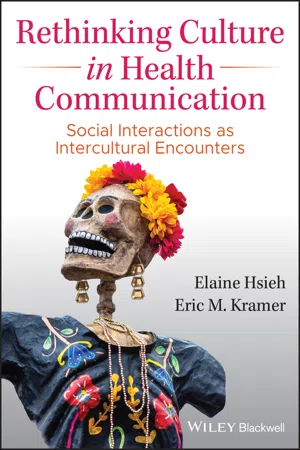
Rethinking Culture in Health Communication
Social Interactions as Intercultural Encounters
- English
- ePUB (mobile friendly)
- Available on iOS & Android
Rethinking Culture in Health Communication
Social Interactions as Intercultural Encounters
About This Book
Rethinking Culture in Health Communication
An interdisciplinary overview of health communication using a cultural lens—uniquely focused on social interactions in health contexts
Patients, health professionals, and policymakers embody cultural constructs that impact healthcare processes. Rethinking Culture in Health Communication explores the ways in which culture influences healthcare, introducing new approaches to understanding social relationships and health policies as a dynamic process involving cultural values, expectations, motivations, and behavioral patterns. This innovative textbook integrates theories and practices in health communication, public health, and medicine to help students relate fundamental concepts to their personal experiences and develop an awareness of how all individuals and groups are shaped by culture.
The authors present a foundational framework explaining how cultures can be understood from four perspectives— Magic Consciousness, Mythic Connection, Perspectival Thinking, and Integral Fusion —to examine existing theories, social norms, and clinical practices in health-related contexts. Detailed yet accessible chapters discuss culture and health behaviors, interpersonal communication, minority health and healthcare delivery, cultural consciousness, social interactions, sociopolitical structure, and more. The text features examples of how culture can create challenges in access, process, and outcomes of healthcare services and includes scenarios in which individuals and institutions hold different or incompatible ethical views. The text also illustrates how cultural perspectives can shape the theoretical concepts emerged in caregiver-patient communication, provider-patient interactions, social policies, public health interventions, and other real-life settings. Written by two leading health communication scholars, this textbook:
- Highlights the sociocultural, interprofessional, clinical, and ethical aspects of health communication
- Explores the intersections of social relationships, cultural tendencies, and health theories and behaviors
- Examines the various forms, functions, and meanings of health, illness, and healthcare in a range of cultural contexts
- Discusses how cultural elements in social interactions are essential to successful health interventions
- Includes foundational overviews of health communication and of culture in health-related fields
- Discusses culture in health administration, moral values in social policies, and ethics in medical development
- Incorporates various aspects and impacts of the COVID-19 pandemic as a cultural phenomenon through the lens of health communication
Rethinking Culture in Health Communication is an ideal textbook for courses in health communication, particularly those focused on interpersonal communication, as well as in cross-cultural communication, cultural phenomenology, medical sociology, social work, public health, and other health-related fields.
Frequently asked questions
Information
1
Rethinking Culture in Health Communication
I. The Expanding and Interconnected Fields of Health Communication



A. The Landscape of Health Communication
1. Persuasion and Behavioral Change: Public Health Campaigns
Table of contents
- Cover
- Title page
- Copyright
- Dedication
- Table of Contents
- Acknowledgement
- 1 Rethinking Culture in Health Communication
- 2 Cultural Consciousness I: Magic Consciousness and Emotions in Health
- 3 Cultural Consciousness II: Mythic Connection and the Social Meanings of Health and Illness
- 4 Cultural Consciousness III: Perspectival Thinking and the Emergence of Modern Medicine
- 5 Cultural Consciousness IV: Integral Fusion and Health Professionals in Healthcare Settings
- 6 Culture and Health Behaviors: Culture Assumptions in Health Theories and Practices
- 7 Health Literacy: Cultural Approaches to Health Behaviors and Decision-Making
- 8 Group-Based Identities: Cultural Approaches to Social Stigma and Health Practices
- 9 Uncertainty in Health and Illness: From Perspectival Thinking to Integral Fusion
- 10 Social Support: Understanding Supportive Relationships Through Cultural Perspectives
- 11 Transformative Technologies: Cultural Approaches to Technologies in Health Contexts
- 12 Health Disparities: Observations and Solutions Through Different Cultural Approaches
- 13 When Cultural Perspectives Collide: Community-Based Health Interventions in Marginalized Populations
- 14 Distributive Justice: Embedding Equity and Justice in Structural Barriers and Health Policies
- Index
- End User License Agreement